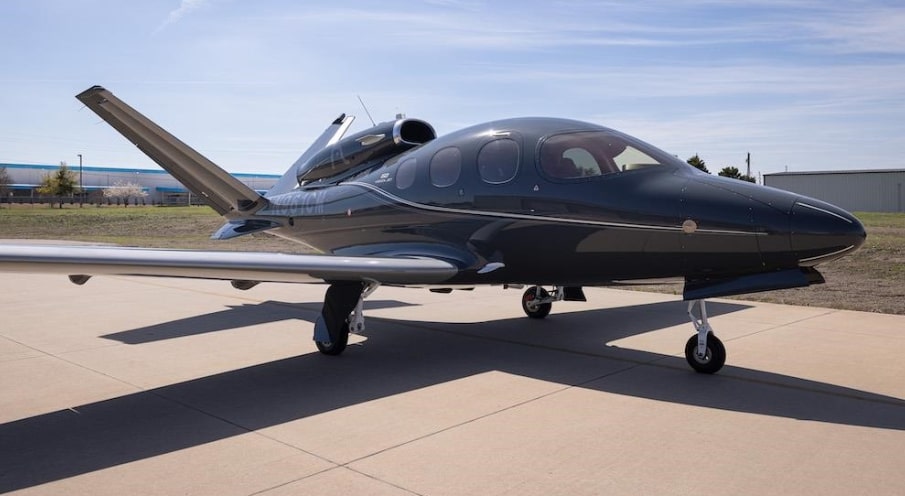No products in the cart.
Cirrus Vision SF50 – G2 Private Jet

The Cirrus Vision SF50 is currently the best-selling single-engine general aviation personal jet in the world. It seats seven including the pilot.
Pilots will enjoy a state-of-the-art Garmin G1000 avionics suite, which includes Safe Return Emergency Autoland. The company also offers a maintenance package to keep the aircraft operating at peak performance.
Design
The Cirrus SF50 Vision Jet is not your typical private jet. Rather than being a step up from a standard piston airplane, the company took a fresh approach and built an all-composite aircraft that looks as elegant on the ground as it does in flight. In fact, it’s designed to look like a step up from an SR22T and hides all of the complex jet functions behind the scenes, adopting an “out of sight, out of mind” philosophy that makes the aircraft easy to operate.
The Vision Jet is also the only small jet to have a fully integrated auto-land feature that will take over at the touch of a button and land itself at the closest airport. This option, called Safe Return, has been tested extensively and is considered one of the most advanced in the industry. It works by monitoring the aircraft’s engine and flight parameters to ensure that all systems are functioning properly. If they aren’t, the parachute will be deployed, which will control the rate of descent and reduce the forces of impact.
While no one expects to use this system, the company believes that it will provide peace of mind to owners and help them make smart decisions when flying. As a result, the company includes it as an optional feature on all of their new aircraft.
When the aircraft first entered production, it was marketed as a “personal private jet” and promised to fly as fast as many light jets but at a fraction of the cost. However, the company’s original estimates were too optimistic, and the aircraft is not as fast or capable as some other similar models.
Despite this, the Vision Jet is still an excellent option for pilots and passengers looking to get from point A to point B in comfort. The aircraft can carry up to six people and has a range of more than 1,200 nm, which means it can fly from New York to Dallas or London to St. Petersburg.
The SF50 G2 is an updated version of the original Vision Jet and features several improvements. It has a higher service ceiling, autothrottle, lithium-ion batteries, and upgraded avionics. Plus, it is also certified for RSVM (Reduced Vertical Separation Minimums).
Engine Specs
Despite its small size, the Vision Jet packs a big punch. In fact, it’s one of the few very light jets that can compete with larger turbofan aircraft in terms of range and payload capacity.
The SF50 was designed and built by Cirrus Aircraft of Duluth, Minnesota. Cirrus began accepting deposits for the aircraft in 2006, and potential buyers had no idea what the finished product would look like when they placed their deposit. The company mailed out small pieces of an aircraft drawing to potential buyers like a jigsaw puzzle, creating considerable curiosity in the aviation community and media coverage.
When the SF50 did make its debut, it was a sensation. The plane offers several unique features, including a glass cockpit with side yoke controls and the Cirrus Perspective Touch system with two high-resolution displays and three touchscreens. The SF50 is also certified for Flight Into Known Ice, meaning pilots can fly over weather that might otherwise cause icing and divert to another airport.
In addition to the safety features, the SF50 is one of the most economical jets in its class. During a typical flight, the SF50 uses 50 gallons per hour – only about double the amount that your family car can consume in the same timeframe. This low fuel burn is largely due to the efficient design of the engine and the airplane’s aerodynamics, which minimize drag.
The SF50 has received some upgrades since its original release. The latest model, the G2+, provides optimized performance for expanded mission capabilities and Gogo inflight WiFi. In addition, the G2+ has better takeoff performance and range, and can use a longer runway than earlier models.
The SF50 has 107 aircraft in operation worldwide as of 2022, with North America accounting for the largest percentage at 83%. This single-engine aircraft is a popular choice for entry level private jet owners, who can then upgrade to a bigger plane down the line as their needs grow.
Top Speed
The Cirrus SF50, also known as the Vision Jet, is the first civilian single-engine jet. It was designed to be a natural step up from the popular SR22T piston model, and it hides many of the complex jet functions behind a simple user interface. This makes it easy to fly and even allows a pilot who has flown piston aircraft before to feel at home in the cockpit. In addition, the Vision Jet has auto-throttles and an automatic flight director that help to reduce the pilot’s workload.
It is powered by a Williams International FJ33-5A turbofan engine with takeoff and maximum continuous thrust limits of 1,846 lb. It has a basic empty weight of 3,550 lb. and a usable fuel capacity of 296 gal. The aircraft is certified to fly into known icing conditions and features the Cirrus Airframe Parachute System (CAPS), which deploys in an emergency to control the rate of descent and minimize the forces at impact.
The SF50 is the only VLJ to feature a fully glazed cabin and large windows that draw in natural light, which mitigates altitude fatigue, vertigo, and claustrophobia. It has seats for five adults, two children, and luggage. The cabin is highly configurable and offers a variety of seating arrangements. Cirrus offers a wide array of personalization options through their Xi Design Studio in Knoxville, Tennessee.
In 2019, the SF50 received an upgrade to the G2 variant. The G2 version adds a higher maximum operating altitude and improved avionics. It is equipped with the Cirrus Perspective Touch + Garmin G3000 avionics suite and includes autoland and autothrottle. The G2 is RVSM capable from the factory and can be operated at flight levels up to 31,000 ft.
The SF50 compares favorably with other entry-level jets in its class, such as the Embraer Phenom 100. The Vision Jet has a lower cost per mile, which is defined as the estimated costs of a trip including fuel, maintenance labor, parts, and miscellaneous expenses. Chart C compares the SF50 with the Phenom 100 using this definition. The SF50 is cheaper by more than 50%.
Purchase Price
The Cirrus Vision Jet is the first very light jet that a pilot-owner can operate on their own. It was designed by US based manufacturer Cirrus Aircraft as their entry into the booming Very Light Jet (VLJ) market. It is a composite single-engine jet that has a large cabin and can seat up to 7 people, including the pilots. It has a lower price tag than most VLJs, making it more accessible to pilot-owners. It also offers higher performance than other VLJs on the market, allowing it to fly faster and higher.
It is fitted with the Cirrus Perspective Touch + (Garmin G3000) avionics suite, which features an autothrottle, electronic stability protection, and envelope protection. These advanced systems help reduce the workload on the pilot and allow them to fly more safely. Additionally, the aircraft is equipped with the Cirrus Airframe Parachute System (CAPS), which allows the pilot to land their jet after an emergency.
In addition to the standard avionics suite, the Vision Jet G2 features several optional upgrades. These include the ability to operate at flight level 310 (31,000 feet), which increases the maximum cruise speed and range of the aircraft. The G2 also comes with the Home Button, which is a feature that allows the aircraft to return to its home position automatically after an engine failure.
Buyers should keep in mind that, like most aircraft, the Cirrus Vision Jet G2 requires a type-certificate. The certificate will cost about $1,500 per year to maintain. In addition, the aircraft will require a yearly inspection and maintenance. Buyers should consider this expense when calculating the purchase price of the jet.
As with all aviation equipment, the purchase price of the aircraft is only one factor to take into account when evaluating its value. It is also important to consider the hourly variable costs that will be incurred when operating the jet. These costs are made up of fuel, maintenance, crew, landing and handling fees, and other various expenses that will change based on the number of hours flown.
Buyers interested in purchasing the 2021 CIRRUS VISION SF50- G2 PRIVATE JET should contact an experienced aviation broker to discuss their options and the best way to finance this unique private jet. The brokerage will be able to connect buyers with the right lenders and brokers, and help them get started on their journey to owning this iconic jet.














